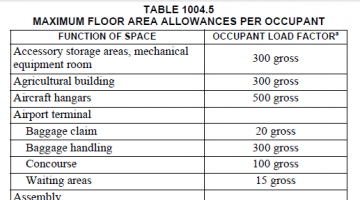-
Welcome to the new and improved Building Code Forum. We appreciate you being here and hope that you are getting the information that you need concerning all codes of the building trades. This is a free forum to the public due to the generosity of the Sawhorses, Corporate Supporters and Supporters who have upgraded their accounts. If you would like to have improved access to the forum please upgrade to Sawhorse by first logging in then clicking here: Upgrades
You are using an out of date browser. It may not display this or other websites correctly.
You should upgrade or use an alternative browser.
You should upgrade or use an alternative browser.
IPC 403.1 Min - passenger terminal
- Thread starter 1849
- Start date
Yankee Chronicler
Registered User
I see that - but that means - a train platform needs no plumbing facilities?Occupant load is determined in accordance with IBC section 1004 and Table 1004.5. Occupant loads are based on square footage, not time. Here's the part of the table you need:
View attachment 13212
Yankee Chronicler
Registered User
I see that - but that means - a train platform needs no plumbing facilities?
How did you arrive at that conclusion? I would consider a train platform to be a concourse. What do you classify it as?
1004.5 Areas without fixed seating. The number of occupants
shall be computed at the rate of one occupant per unit of
area as prescribed in Table 1004.5. For areas without fixed
seating, the occupant load shall be not less than that number
determined by dividing the floor area under consideration by
the occupant load factor assigned to the function of the space
as set forth in Table 1004.5. Where an intended function is not
listed in Table 1004.5, the building official shall establish a
function based on a listed function that most nearly resembles
the intended function.
I don't disagree w/ that conclusion but concourse is listed under airport terminal, I find the definition of concourse to be described as interior. If the platform is fully outside hard to quantify occupancy?How did you arrive at that conclusion? I would consider a train platform to be a concourse. What do you classify it as?
That was why I wondered if passengers per day? might be a better metric.
Yankee Chronicler
Registered User
Where an intended function is not
listed in Table 1004.5, the building official shall establish a
function based on a listed function that most nearly resembles
the intended function.
A train terminal is not an airport, but the table doesn't list bus terminals or marine terminals, either. The code says for functions not listed, to use the function that most nearly resembles the intended function. Ultimately, it's the Building Official's determination that matters. Have you discussed this with him/her?
I don't see this being an outdoor terminal as making any difference. IBC definitions:
BUILDING. Any structure utilized or intended for
supporting or sheltering any occupancy.
There could be 100,000 passengers per day, but only 1,000 at one time.That was why I wondered if passengers per day? might be a better metric.
Yankee Chronicler
Registered User
My experience in the days when I rode commuter trains was that people tended to know where the car doors would be when the trains stopped, and they would cluster there -- in a tight cluster for which a ratio of 1:5 sf would probably be light. But fewer people tended to migrate to the ends of the platform, so overall a ratio of 1 person to 5 square feet would certainly be adequate, and you might talk the AHJ into using a ratio of 1:7 if you conduct field observations at similar stations serving the rail line in question..
Wecline1
Registered User
Would the platform not be an accessway to the terminal building itself? Short access ways are usually accessories to the main building. The main building would have the occupancy load requiring bathroom accommodations, not the "loading ramp". Although, in California, I'm sure they would want the occupancy load of the platform added to the terminal occupancy load.
In this case it is a train station built without interior space. I believe they should be required to put in restrooms, it could be based on a occupancy of the train they are loading? As the local and state government are scared of the train, they probably won't be required to do anything. Doubtful building codes are used for this project.
Wecline1
Registered User
In California, we have these areas labeled "Transit Stations". Basically, just the loading platform with access to parking and sometimes bus stops. They are usually not associated with bathrooms, perhaps because there is not intent to have people linger, much like a street bus stop. I think you are correct, in the assessment of the lack of authority of the plumbing code requirements or local building department.
"
"

